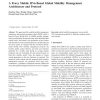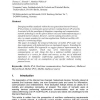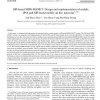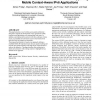MONET
2010
14 years 9 days ago
2010
This paper specifies a global mobility management architecture and protocol procedure called GPMIP, which is based on Proxy Mobile IPv6. In GPMIP, mobility management is performed ...
WICOMM
2008
14 years 1 months ago
2008
With the recent advances in portable devices and wireless networks, a new paradigm of computing has emerged which is known as mobile computing. In general mobile computing can be ...
CORR
2004
Springer
14 years 1 months ago
2004
Springer
Emerging mobility standards within the next generation Internet Protocol, IPv6, promise to continuously operate devices roaming between IP networks. Associated with the paradigm o...
CN
2007
14 years 1 months ago
2007
In recent years, network mobility (NEMO) has been studied extensively due to its potential applications in military and public transportation. NEMO basic support protocol (NBSP), ...
IJNSEC
2008
14 years 1 months ago
2008
Security is a critical design issue in Mobile IPv6 since adversaries can take advantage of its routing process and arbitrarily channelize the traffic to different destinations. Th...
COMCOM
2006
14 years 1 months ago
2006
In this paper, we designed and implemented an integrated wireless system, namely a SIP-based MIP6-MANET system. This SIP-based MIP6MANET system is an integration and implementatio...
WMI
2001
14 years 3 months ago
2001
This paper presents a novel wireless access point architecture designed to support the development of next generation mobile context-aware applications over metropolitan scale are...
IADIS
2004
14 years 3 months ago
2004
Mobile IPv6 is thought to be dominant protocol for providing mobility. In the near future, most portable communication devices will deploy Mobile IPv6 mechanism. Our main concerns...
NETWORKING
2007
14 years 3 months ago
2007
One of the current challenge of the Mobile IPv6 Working Group at the IETF is to dynamically assign to a Mobile Node its Home Agent, Home Address and to setup necessary security ass...
ACSAC
2002
IEEE
14 years 6 months ago
2002
IEEE
In the Mobile IPv6 protocol, the mobile node sends binding updates to its correspondents to inform them about its current location. It is well-known that the origin of this locati...




